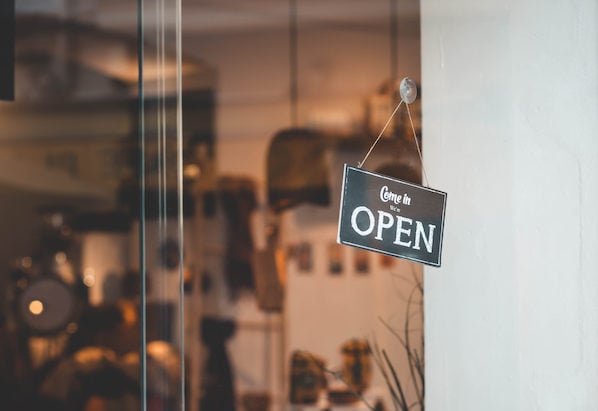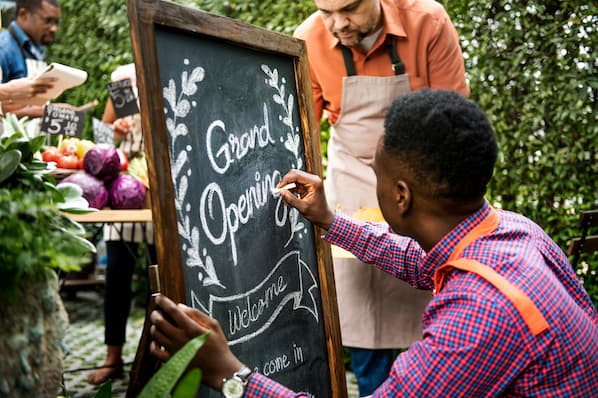Last year, I decided that I wanted to invest in personal training.

As a lifelong sedentary person, I realized that I didn't know how to start, so I went to the almighty Google machine.
I typed in "personal trainers Orange County," looked at the top results, and examined the reviews.
Before scheduling any consultations, I narrowed down the options based on their fitness philosophy (seen on their website) and the most highly rated.
When searching for a local business, this approach and process isn't unique.
In fact, 90% of consumers used the internet to find a local business in the last year.
That's why, as marketers, our businesses have to show up when people are searching for local companies online.
Below, let's review the top strategies to promote your business locally.
How to Promote Your Business Locally
- Plan out your process with a marketing strategy template.
- Advertise with local audience targeting.
- Create a blog strategy catering to a local audience.
- Post locally appealing content to social media.
- Get set up with online directories.
- Be involved in the community.
- Create a loyalty program.
- Build an email list.
- Use traditional methods.
1. Plan out your process with a marketing strategy template.
Before you spend any money or develop any creatives, take some time to document your steps, budget, and expectations with a custom marketing plan. Starting here will help you think through any possible roadblocks and organize your plans more concretely.
Instead of starting from scratch, try using HubSpot's pre-built Marketing Plan Template, which you can download for free and start working with immediately.
Download the Marketing Plan Template
2. Advertise with local audience targeting.
Online advertising is one of the main ways to show up in local searches. In fact, you should use both social media and search engine advertising to promote your business locally.
With local advertising, you'll have to set up location targeting and write copy that uses specific language targeted to your local audience.
And with marketing tools like HubSpot, you can use local audience targeting directly in your software.
With local audience targeting, you can choose a specific location to show your ad. This means using zip codes or geographic regions.
However, local audience targeting isn't just about selecting a certain location. It's also about using the right keywords and the right language to appeal to that audience.
For instance, you can use locations in your page titles and meta descriptions. Just adding the words "Orange County" in your description could mean the difference between a click and a scroll by.
Additionally, you should use tools like Google Trends to see which keywords are more popular in a given location. If you serve several locations, you might choose one keyword over the other.
In my example, perhaps the term "fitness instructor" is more popular than "personal trainer" in Southern California. If that's the case, then personal trainers should adjust the language in their ads.
Alongside advertising, you might be investing in public relations as well. If so, don't forget to have a local PR strategy.
3. Create a blog strategy catering to a local audience.
We've been fans of the blog for a long time at HubSpot. That's because you can use your blog to attract the right audience and convert visitors who are interested in your product.
This is especially true for local businesses.
To start, blogging is an important SEO strategy to consider. By creating educational content, you can rank for local keywords and raise brand awareness.
The more content you have that ranks, the better.
Plus, with HubSpot's marketing tool, you can get instant SEO suggestions for your blogs as you write them.
To further promote your local business, you can cater your blogging strategy to your local audience. This means that you can create blogs like "best places to eat in OC" if you have a restaurant.
Local guides and tips and tricks posts are popular among local audiences. When users are searching for a local business online, you want your blogs to appear on search results.
4. Post locally appealing content to social media.
So, in case I haven't said it enough, posting local content is a great way to attract a local audience.
I'm repeating this idea because it's that important, whether we're discussing blog posts, search strategies, or social media.
I'll say it again: The content you post should appeal to your local audiences.
In regards to social media, this means that you're using the right hashtags for your area and tagging the locations in your posts.
Additionally, being active on social media can help you rank higher in search engines. The more active you are online, the easier it is for local audiences to find you.
Again, using a marketing tool like HubSpot can help you do this in one place.
5. Get set up with online directories.
Don't forget to get set up with online directories. It's perhaps one of the most important components of promoting your business locally.
This includes directories such as Google My Business, Yelp, Facebook, or Bing. Tools like Moz Local can help you get this done in one place.
With data aggregator tools, your local information will be sent out to several directories. Plus, they can help keep your data consistent.
Having a different address or phone number on your Facebook and Google will confuse your audience. When audiences are confused, they stop considering your company in their purchasing decision.
That's why it's so important that your name, address, and phone number (NAP) is consistent online.
Additionally, your online directory listings should include reviews. Reviews are one of the main factors of a user's purchasing decision when looking at local businesses. Just think back to my search for a personal trainer. I only considered the highly rated trainers.
Plus, all of this helps with your local SEO. Being visible on directories and in reviews can help improve your search rankings, making it easier to find you online.
6. Be involved in the community.
While promoting your business locally can seem like a hard task, just being involved in your community can make a big difference.
Community events are a great way to get in front of your local audience.
For example, if there's a local fundraiser, maybe you want to become a sponsor. Or perhaps you want to get involved with local charities. Or maybe you want to become involved with the local chamber of commerce.
These tactics can help you raise brand awareness locally and promote your business to your local audience.
7. Create a loyalty program.
Loyalty programs are a great way to keep people coming back for more.
When you create a customer loyalty program, it should be fun, and ultimately, deliver value to your customers.
Perhaps customers can get points and redeem rewards. Maybe they have to play a game to get points. Either way, they're more likely to keep coming back.
People like to have fun and this will help them create a connection with your brand, which is important to retaining customers.
In fact, Sophia Bernazzani says"Studies show that customers who have an emotional connection to your brand tend to have a lifetime value that's four times higher than your average customer. These customers spend more with your business, and therefore, should be rewarded for it. After all, you need them the most."
Whether you're a new or established business, you should consider creating a loyalty program to incentivize repeat customers.
8. Build an email list.
Once you've started to gain traction as a local business, either with your customer loyalty program or through local search marketing, you should start to grow your email list.
Email marketing can be vastly underrated, even though it's still one of the most effective marketing channels.
When it comes to promoting your business locally, you can use segmented email lists to create campaigns targeted directly to your local audience.
If you haven't started an email list yet, building an email list doesn't have to be hard. Keep in mind that your emails should provide value to your audience.
Ultimately, you should be using the methods above to collect emails. For example, if you're sponsoring a charity event, make sure you have a table and email sign up list. Or if you have a customer loyalty program, you should be collecting email addresses to send them rewards and exclusive deals.
To get started sending emails, make sure you have an email marketing tool like HubSpot.
9. Use traditional methods.
We would be remiss if we didn't mention traditional methods can also be used to market your local business.
For example, you can contact your local press and get spots on the local radio show or in the local newspapers to raise visibility.
Additionally, traditional methods like direct mailers are great for promoting your business locally. With mailers, you can reach your local audience and build brand awareness.
Promoting your business locally can seem like a daunting task. But it doesn't have to be. There are plenty of methods you can use to show up online and in the community to raise brand awareness on a local level.
![→ Download Now: SEO Starter Pack [Free Kit]](https://no-cache.hubspot.com/cta/default/53/1d7211ac-7b1b-4405-b940-54b8acedb26e.png)



![What is Localized Content [+When to Use It]](https://53.fs1.hubspotusercontent-na1.net/hubfs/53/localized-content.jpg)






![What Is Local PR and How Does It Work? [Examples]](https://53.fs1.hubspotusercontent-na1.net/hubfs/53/local-pr.jpg)
![What is Local Advertising and How Does it Work? [+ Examples]](https://53.fs1.hubspotusercontent-na1.net/hubfs/53/local-advertising.jpeg)